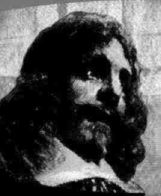

Little is known about Girard Desargues' personal life. It is known that his family had been very rich for several generations, and had supplied lawyers and judges to the Parlements in Paris and Lyon. It is thus clear that Desargues had every opportunity of acquiring a good education, could afford to buy what books he chose, and had leisure to indulge in whatever pursuits he might enjoy. In his later years, these seem to have included designing an elaborate spiral staircase, and an ingenious new form of pump, but the most important of Desargues' interests was geometry.
When in Paris, Desargues became part of the mathematical circle surrounding Mersenne, including Descartes and Pascal. It was probably for this limited readership of friends that Desargues
prepared his mathematical works, and had them printed. Desargues wrote on "practical" subjects such as perspective, the cutting of stones for use in building, and sundials. His writings are, however, dense in content and theoretical in their approach to the subjects concerned. There is none of the wordy and elementary step-by-step explanation which one finds in texts that are truly addressed to artisans.
Desargues' most important work is the one in which he invented projective geometry. Only one copy is now known to survive. The book is short, but very dense. It begins with pencils of lines and ranges of points on a line, considers involutions of 6 points, gives a rigorous treatment of cases involving "infinite" distances, and then moves on to conics, showing
that they can be discussed in terms of properties that are invariant under projection.
Desargues' famous "perspective theorem" was first published in 1648 in a work on perspective by Abraham Bosse.
It is clear that Desargues is well aware of the work of ancient geometers such as Apollonius and Pappus. His choosing to explain himself differently
may perhaps be due to his recognition that his own work was also deeply indebted to the practical tradition, specifically to the study of perspective. It seems highly likely that it was in fact from his work on perspective and related matters that Desargues' new ideas arose. When
projective geometry was reinvented, by the pupils of Gaspard Monge, the reinvention was from descriptive geometry, a technique that has much in common with perspective.